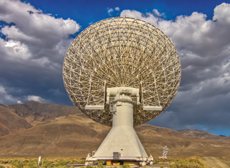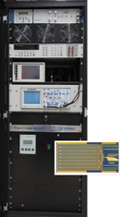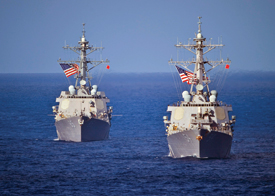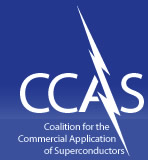Commercial Applications
- Properties, History and Challenges
- Overview
- Electric Power
- Transportation
- Medical Imaging and Diagnostics
- NMR for Medical and Materials Applications
- Industrial Processing
- High Energy Physics
- Wireless Communications
- Instrumentation, Sensors, Standards and Radar
- Large-Scale Computing
- Renewable Energy
- Cryogenics: An Enabling Technology
Applications in Instrumentation, Sensors, Standards and Radar
Superconducting devices are so accurate they define the “Volt,” goes the saying. The true testament to the intrinsic accuracy that results from the properties of superconductors is that the metrology standard for realizing the electrical unit of “Volt” is indeed a superconducting circuit. In addition to accuracy, superconductors enable the most sensitive detectors of electromagnetic radiation and are used in scientific research both at ground-based astronomy observatories as well as in space-based NASA missions.
Instrumentation
The earliest applications of superconducting electronics were, and continue to be, custom instruments based primarily on superb sensitivity in detecting magnetic fields. These instruments are based on various designs of SQUIDs and find applications in research laboratories for physics, chemistry and materials science research as well as in field geological expeditions such as airborne detection of salt domes, a frequent indicator of potential new oil fields.
Sensors
 Besides being ultrasensitive detectors of magnetic fields, superconductors also excel in the detection of extremely faint electromagnetic signals, for example signals originating in outer space. SQUID detectors hold the record in sensitivity and are used in many a radio astronomy observatory worldwide. The detectors are used in several modes,
including as discriminators of the various frequencies of the incoming signals, as in the Radio Observatory featured in the figure, as well as in camera mode providing infrared images of astronomical objects, an example being the SCUB-2 infrared camera on the James Clerk
Maxwell telescope in Hawaii. [1]
Besides being ultrasensitive detectors of magnetic fields, superconductors also excel in the detection of extremely faint electromagnetic signals, for example signals originating in outer space. SQUID detectors hold the record in sensitivity and are used in many a radio astronomy observatory worldwide. The detectors are used in several modes,
including as discriminators of the various frequencies of the incoming signals, as in the Radio Observatory featured in the figure, as well as in camera mode providing infrared images of astronomical objects, an example being the SCUB-2 infrared camera on the James Clerk
Maxwell telescope in Hawaii. [1]
Standards
 It took several decades of research and international collaboration to realize that superconducting devices can be the basis for a metrology standard for the electrical unit of the Volt. This is due to a fundamental property of a key superconducting element, the “Josephson Junction,” which acts as a frequency-to-voltage converter. Primary voltage standard systems, based on this
principle, are now in virtually every national metrology laboratory, as well as in many advanced industrial research laboratories. The systems are available commercially for generating and calibrating any static voltage up to 10 Volts with accuracy up to 5 parts per billion. Continuing research by the National Institute of Science and Technology (NIST)
in the U.S. and similar institutions worldwide is focused on developing AC-voltage
standards as well as arbitrary signal generators with the precision and accuracy of the
existing DC-standards.[2]
It took several decades of research and international collaboration to realize that superconducting devices can be the basis for a metrology standard for the electrical unit of the Volt. This is due to a fundamental property of a key superconducting element, the “Josephson Junction,” which acts as a frequency-to-voltage converter. Primary voltage standard systems, based on this
principle, are now in virtually every national metrology laboratory, as well as in many advanced industrial research laboratories. The systems are available commercially for generating and calibrating any static voltage up to 10 Volts with accuracy up to 5 parts per billion. Continuing research by the National Institute of Science and Technology (NIST)
in the U.S. and similar institutions worldwide is focused on developing AC-voltage
standards as well as arbitrary signal generators with the precision and accuracy of the
existing DC-standards.[2]
Radar
 Superconductive electronics can dramatically enhance anti-ship
missile defense radars. Emerging threats include sea-skimming missiles that reflect very small fractions of the total radar signal. The challenges to the radar receivers are that they must distinguish these small echoes from the huge background clutter of waves, rain, jammers and mountains on the shore in real time. Superconductivity enables the highest dynamic range digitizers and the smallest digits are meaningful to detect the most elusive threats. High dynamic range superconductive electronics provide the most advanced technology
and simplify the receiver, thereby making these life-saving sensors affordable for a wide
variety of Navy ships. [3]
Superconductive electronics can dramatically enhance anti-ship
missile defense radars. Emerging threats include sea-skimming missiles that reflect very small fractions of the total radar signal. The challenges to the radar receivers are that they must distinguish these small echoes from the huge background clutter of waves, rain, jammers and mountains on the shore in real time. Superconductivity enables the highest dynamic range digitizers and the smallest digits are meaningful to detect the most elusive threats. High dynamic range superconductive electronics provide the most advanced technology
and simplify the receiver, thereby making these life-saving sensors affordable for a wide
variety of Navy ships. [3]
Issues and Recommendations
Besides continued support for the R&D required to advance these devices and their applications, an enabling technology important in facilitating the adoption of these applications, and the concomitant improvement in performance of the systems they support, is a more efficient and reliable cryocooling system that is transparent to the end user. Advances are indeed occurring in this area but at a slow pace. Acceleration of this development along with increased support for manufacturing would be of great benefit to industrial superconducting applications as we move from research and development to commercial deployments.
- [1] The NASA Radio Observatory in Owens Valley, CA, relies on superconducting detectors Image Courtesy of Jack Freer, Overland Photography
- [2] Primary Voltage Standard used to define the “Volt” Image Courtesy of NIST and Hypres Inc.
- [3] "Superconductive digitizers enable ship self-defense radars to sense the small echoes from sea-skimming missile threats. “USS McCampbell and USS Curtis Wilbur transit Pacific Ocean,” by official U.S. Navy Imagery, is licensed under CC BY 4.0

